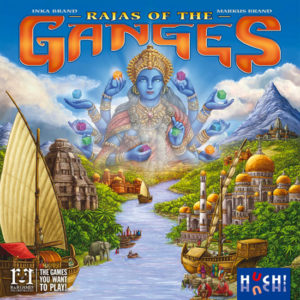 Some designers strike a chord with gamers because they routinely craft games with certain mechanisms. Devoted fans come to expect these types of games. Furthermore, designers will borrow heavily from other designers just to stir the pot a bit and develop something new.
Some designers strike a chord with gamers because they routinely craft games with certain mechanisms. Devoted fans come to expect these types of games. Furthermore, designers will borrow heavily from other designers just to stir the pot a bit and develop something new.
Such is the case with Rajas of the Ganges. On the cover, designers Inka and Markus Brand are a tag-team powerhouse of designs with everything from Escape the Room style games to children’s games. One of their more notable titles is Village, a Kennerspiel des Jahres award winner from 2011. However, with Rajas of the Ganges, Inka and Markus have developed something which looks like it could have been a design collaboration between Stefan Feld and Vital Lacerda.
Rajas on the Ganges a worker placement, tile laying, race game for 2-4 players that takes about 25 minutes per player. And it plays best with any number of players.
Gameplay Overview:
The overall goal of Rajas of the Ganges relates to two tracks on the main board: a money track and a fame track. Each of these is stocked with a player marker, and the tracks progress around the board in opposing directions. Additionally, players will have personal boards that hold the tiles they’ve selected for their province and “Kali statue” boards to hold dice.
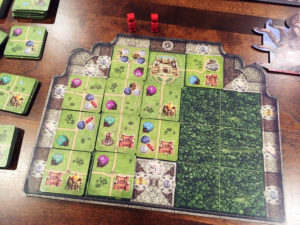
The main board has a multitude of spaces for placing workers. In order to place a worker, a player will have to spend money and/or a certain value of dice. The dice, whenever collected, are rolled for a random value and act as resources of four unnamed types in the game.
In aid of the goal of moving up the money and/or fame track, the basic actions in the game involve purchasing land tiles to place on the personal board. These tiles have a variety of temples or markets on them. Markets can be activated to move up in wealth. Temples, as soon as they’re built, award fame. In addition, if a player has upgraded their temple construction abilities, the different colored temples become worth more fame.
Alongside these basic actions are additional actions to manage a player’s dice. Since the dice are randomized when acquired, players may need to modify dice by spending Karma, replace dice, or simply acquire new dice and/or refill Karma.
Players can also gain a variety of rewards by moving their boat down the river track. This provides a more random series of bonuses, but could be crucial to get certain resources or track movements. This also provides another worker to acquire in addition to the wealth and fame tracks.
The end of the game activates when one player’s fame and money markers cross each other. This could be when a player is high in money and low in fame, highly famous and poor, or somewhere in the middle. In either case, the round is completed and the player who has the money and fame markers past each other by the highest amount wins.
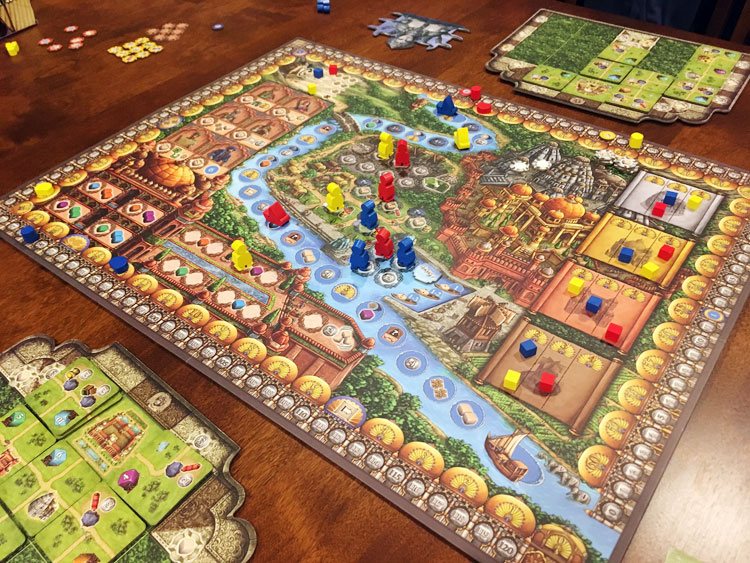
Game Experience:
The theme is one of competing Rajas in 16th century India. In a sort of Castles of Burgundy meets New Delhi style theme, the players are nobles intent on increasing their influence by showing off how they can improve their lands and acquire wealth and/or fame. As noted above, players take actions through worker placement on the main board while at the same time using player boards with a sort of Carcassonne mini-game to improve their lands. It sounds like a lot, but it really does make sense.
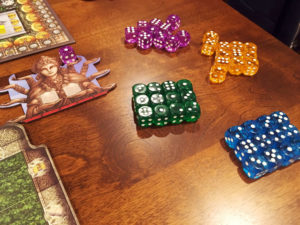
At the beginning of this article, Stefan Feld and Vital Lacerda were mentioned and not lightly. Rajas of the Ganges feels like a direct collaboration between these two designers with the gorgeous hand of Dennis Lohausen coating the whole delicacy. The dice mechanisms from Feld and the intertwined puzzly nature of worker placement, characteristic of Lacerda, feels totally familiar and enjoyable.
The strategic choices in Rajas of the Ganges hinge mostly on which track a player will focus on and how far they choose to develop their personal board with temples or markets. Playing the basic game will present only a beginning challenge and players should really immediately graduate to the advanced variants for the real game. Even the small rules changes therein have a big impact on play.
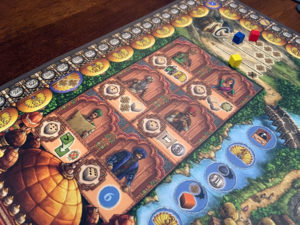
The negative could be said that all of this is old hat. There’s nothing remarkably new here, and besides the twist of having two scoring markers pass each other, the rest of the play style is completely familiar. This is still welcome because there’s just enough variety here for an enjoyable, fresh experience. Players who might already be souring on worker placement or dice resource games might not even welcome it.
The other complaint is one familiar to Euro gamers. The theme, while implemented very well with all the visual flourishes and explanation in the rules of the various actions on the board, still feels like a veneer. This is really a minor criticism because it’s hard to get the true feeling of the theme from many dice-centric games.
Final Thoughts:
Rajas of the Ganges is a wonderful tread through familiar territory with just a twist of difference. The Indian theme coupled with mechanisms reminiscent of other designers is a delicious achievement both visually and in play. While Rajas of the Ganges won’t blow the hair back of heavy Euro gamers, it’s still a delightful experience. Gamers in need of a quick Euro fix before bed or a nice puzzly wake up game should meditate on picking up a copy.
Final Score: 4 Stars – Even as a light Sunday morning style game, Rajas of the Ganges is just complex enough to yield a thoroughly enjoyable puzzly game.
 Hits:
Hits:
• Dice resource complexity
• Worker placement familiarity
• Intertwining systems
Misses:
• Theme is shallow
























I actually really enjoyed this one at four players. We did the advance variant stuff from the beginning and never had issue. I love the karma track and how you invert the die, a 1 to a 6, etc. I also thought the presentation here was stellar, between the beautiful dice and the bright and colorful board and components.
Thanks for the comments Mark. I’m a big fan of games with this weight and depth. Lots of replayability and great use of theme, even if it is a little shallow.